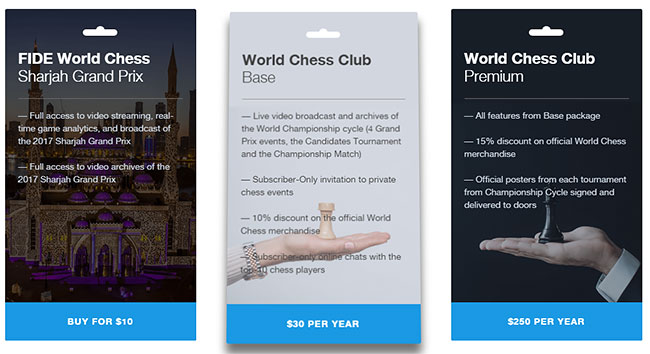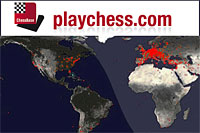The time control in the GP tournaments is 100 minutes for the first 40 moves, 50 minutes for the next 20 moves and then 15 minutes for the rest of the game plus an additional 30 seconds per move starting from move one.
The first leg, in Sharjah, will be held February 18 - 27 (with a rest day on the 23rd) at the Sharjah Cultural & Chess Club. The first prize is €20,000; the total prize fund is is €130,000.
2017 Sharjah GP Participants

All photos by Max Avdeev

One of the perks of this new format is that contrary to the usual Swiss Opens, there is no imbalanced period. This means that while it is usual to start with very strong players paired against much weaken ones, only to give real collisions after a few rounds, here even the very first round will pit elite against elite. There is no grace period, or warmup.

Levon Aronian had an uneventful game against Michael Adams

The same cannot be said of Hou Yifan who brushed against defeat right up to the very end, when her opponent, Li Chao went astray and let her escape.
Li Chao vs Hou Yifan

[Event "FIDE World Chess Grand Prix 2017"] [Site "Sharjah"] [Date "2017.02.19"] [Round "2"] [White "Li, Chao b"] [Black "Hou, Yifan"] [Result "1/2-1/2"] [ECO "D35"] [WhiteElo "2720"] [BlackElo "2651"] [SetUp "1"] [FEN "8/3R2k1/6p1/3K1pP1/3P1r2/8/8/8 b - - 0 74"] [PlyCount "43"] [EventDate "2017.??.??"] [EventType "swiss"] [EventCountry "UAE"] [SourceTitle "playchess.com"] [Source "ChessBase"] [SourceQuality "1"] [TimeControl "40/6000+30:20/3000+30:900+30"] {[#]} 74... Kf8 75. Rd6 $4 (75. Ke6 $1 Re4+ 76. Kf6 f4 77. d5 f3 78. Rf7+ Kg8 79. Kxg6 $18) 75... Kf7 76. Kc6 Rg4 77. Rf6+ Ke7 78. d5 Rc4+ 79. Kb5 Rc1 80. Rxg6 f4 81. Re6+ Kd7 82. Rf6 Rg1 83. Kc5 Rxg5 84. Rf7+ Ke8 85. Rxf4 Rg6 86. Ra4 Kd7 87. Ra7+ Kd8 88. Rb7 Rh6 89. Rg7 Rf6 90. Kd4 Rh6 91. Rf7 Ke8 92. Ra7 Kd8 93. Kc5 Rg6 94. Rf7 Rh6 95. Rg7 Rf6 1/2-1/2

Ding Liren bounced back from his opening defeat and beat Salem Saleh in impressive fashion
Salem Saleh vs Ding Liren

[Event "FIDE World Chess Grand Prix 2017"] [Site "Sharjah"] [Date "2017.02.19"] [Round "2"] [White "Salem, A R Saleh"] [Black "Ding, Liren"] [Result "0-1"] [ECO "C50"] [WhiteElo "2656"] [BlackElo "2760"] [PlyCount "68"] [EventDate "2017.??.??"] [EventType "swiss"] [EventCountry "UAE"] [SourceTitle "playchess.com"] [Source "ChessBase"] [SourceQuality "1"] [TimeControl "40/6000+30:20/3000+30:900+30"] 1. e4 {(0)} e5 {(14)} 2. Nf3 {(0)} Nc6 {(00:03)} 3. Bc4 {(0)} Nf6 {(14)} 4. d3 {( 00)} Bc5 {(31)} 5. c3 {(3)} d6 {(40)} 6. Bg5 {(00:41)} h6 {(2:43)} 7. Bh4 { (21)} g5 {(5:33)} 8. Bg3 {(23)} O-O {(10)} 9. Nbd2 {(44)} a6 {(00:51)} 10. a4 { (1:47)} Ba7 {(2:08)} 11. O-O {( 00:33)} Nh7 {(2:49)} 12. h3 {(35)} Kh8 {(13:52) } 13. d4 {(1:30)} g4 {(5:30)} 14. hxg4 {(19:55)} Bxg4 {(00:06)} 15. Be2 {(13)} Rg8 {(5:57)} 16. Kh1 {( 06:41)} Qf6 {(4:30)} 17. d5 $6 {(4:48) This looks very suspicious. Black's intentions are already crystal clear. The last thing White should be doing is locking down the center.} (17. dxe5 {would have given White a target to focus on and for Black to have to keep an eye on.} dxe5 18. Nh4 { Not only threatening to exchange off the bishops and ease the pressure, but also bring the knight to f5 where it would be extremely strong.} Be6 19. b4 { threatening b5 followed by Nc4 (eyeing the e5 pawn) and White is fine.}) 17... Ne7 {(8:46)} 18. Bh4 {(18:31)} Ng5 {(8)} 19. Nh2 $1 {(1:41) Better late than never, White tries to exchange off some of the pieces threatening his king's health.} Bc8 $1 {(04:10) And just as correctly, Ding Liren is not about to make it easy.} 20. Bg4 {(18:08) "I insist!", says White.} Qg6 {(9)} 21. Bh5 $2 {(07:27) The movee doesn't lose outright, but it is completely illogical. After alll that effort to (correctly) swap off the bishops, White decides to attack the queen... for what? Black's queen is hardly worse off on g7, and White's bishop makes no sense on h5.} Qg7 {(3:49)} 22. g3 $2 {(9:37) This on the other hand loses material.} Bh3 {(4:27) If the rook moves, then Bxf2 will no doubt spell White's doom. A new piece directly in the fray and a valuable defensive pawn out the window.} 23. Bxg5 {(11:23)} hxg5 {(7:36)} 24. Bg4 {(48)} Bxf1 {(00:11)} 25. Qxf1 {(4)} Qg6 {(6:20)} 26. Kg2 {(00:26)} Kg7 {(4)} 27. Nhf3 {(2:00)} Rh8 {(2:52)} 28. a5 {(3)} Ng8 {(12:44)} ({Black misses a cute trick with} 28... Nxd5 $1 29. exd5 (29. Bf5 Qf6 30. Qc4 Ne7 31. Bg4 Ng8 $1 {planning to bring it to h6.}) 29... f5 30. Bh3 g4) 29. Qc4 {(2:02)} Nf6 {(29)} 30. Bf5 { (5)} Qh6 {(24)} 31. Qd3 {(02:36)} Qh5 {(1:39)} 32. Rf1 {(2:21)} Rh6 {(2:09)} 33. Re1 {(28)} Ng4 {(1:52)} 34. Bxg4 {(2)} Qxg4 {(6)} 0-1

Local hero GM Saleh Salem has had a rough start

Ding Liren's victor from round one, Richard Rapport, was less fortunate and was manhandled by MVL

Finally, it was Shakhriyar Mamedyarov who produced the game of the day, as chosen by...

... guest commentator GM Tiger Hillarp-Persson, author of one of the great references on the Modern Defense
Shakhriyar Mamedyarov vs Evgeny Tomashevsky (annotated by GM Tiger Hillarp-Persson)

[Event "Sharjah Grand Prix"] [Site "?"] [Date "2017.02.19"] [Round "2"] [White "Mamedyarov, Shakhriyar"] [Black "Tomashevsky, Evgeny"] [Result "1-0"] [ECO "E12"] [WhiteElo "2766"] [BlackElo "2711"] [Annotator "Tiger Hillarp"] [PlyCount "73"] [EventDate "2016.11.19"] [EventCountry "UAE"] 1. d4 Nf6 2. c4 e6 3. Nf3 b6 {Tomashevsky usually prefers the Queens Indian over the, increasingly popular, Universe involving 3...d5.} 4. a3 {Mamedyarov is the main champion of this line in the world elite, so I presume Tomashevsky must have been well prepared to meet it.} (4. g3 {is by far the most popular move. Both sides have tons of opportunities to diverge here, but it is interesting to compare one of the main lines to the actual game:} Ba6 5. b3 Bb4+ 6. Bd2 Be7 7. Nc3 d5 {This is Karjakin's favourite.} 8. cxd5 exd5 9. Bg2 O-O 10. O-O Re8 11. Ne5 Bb7 {Here White can play in a similar manner to how Mamedyarov goes about it, but it is somewhat more diffiult for White to find good squares for the pieces on the c-file; Ba3 and Nb8-a6(-b4) are thorns in White's side. This is one of the many reasons why Black is happy to lose a tempo with Bc8-a6-b7.}) 4... Bb7 5. Nc3 d5 6. Qc2 $5 {This is quite far down on the list of usual suspects.} ({On of the main points are seen after} 6. cxd5 Nxd5 7. Qc2 Be7 8. e4 (8. Bd2 {is an older move that allows Black to equalize easily with} O-O 9. e4 Nxc3 10. Bxc3 Nd7 11. Rd1 Qc8 {, followed by c5. Perhaps "easily" is a bit too optimistic.}) 8... Nxc3 9. bxc3 O-O 10. Bd3 c5 $1 {,when Black can develop the knight to c6. With the move order in the game, White is hoping that Black will play Nb-d7.}) 6... Nbd7 {Since I have little knowledge about the theory in these lines, I am not so much surprised by this move as I am by its consequences.} 7. cxd5 $1 exd5 {...and we arrive at the consequences that I mentioned on the last move. According to my understanding of chess, this kind of structure is somewhat better for White if there is still the possibility to fianchetto the bishop on g2. Either Tomashevsky made a mistake with his 6th move, or my understanding might need an upgrade. Statistically speaking, the latter is more probable.} (7... Nxd5 {makes less sense with the knight already at d7.} {The engine indicates that} 8. Nxd5 exd5 9. Bg5 $1 Qc8 (9... f6) 10. e3 {is somewhat better for White and there are plenty of games to back up this case.}) 8. Bf4 {A good moment for this move, as Black is rather forced to react the the threat of Nb5.} a6 9. g3 $1 { This move, which seems like the principled reaction, is almost a novelty. I could not be more surprised. One might say that Black's problem here is dual; if he changes the pawn structure, then White's pieces are perfectly placed to attack the weaknesses that will result and if Black sits tight, then the pressure on d5 will eventually force Black to play c7-c6, when e2-e4 will become a problem for Black.} ({Another game played in the United Arab Emirate went} 9. e3 Ne4 $6 10. Nxe4 dxe4 11. Ng5 $1 Nf6 12. Bc4 Bd5 13. Bxd5 Qxd5 14. Qxc7 h6 15. Nxf7 $2 Qa5+ 16. Kf1 Qb5+ 17. Kg1 Nd5 18. Qb7 Rg8 19. Ne5 {1-0, Salem,A (2586)-Petrosyan,M (2407) Al-Ain UAE 2014}) 9... Be7 10. Bg2 {The bishop is better here than on e2, or d3, where it has a greater tendency to become a tactical target for Black (soon to materialize) hanging pawns.} O-O ( 10... Nf8 11. Ne5 Ne6 12. Qa4+ Kf8 13. Rd1 $1 Nxf4 14. gxf4 g6 15. Qb3 Kg7 16. Bf3 $1 Rf8 17. h4 {and the game was soon decided in White's favour, in Lautier, J (2630)-Short,N (2665) Amsterdam 1996.}) 11. O-O Re8 12. Rac1 c5 ({Black can also consider a move like} 12... Nf8 {, but after} 13. Rfd1 Ne6 14. Be5 { Black is struggling to find a good continuation. The risk is that White will set up a terrible bind.}) 13. dxc5 $1 bxc5 14. Ne5 {The engines have nothing bad to say about Black's position here and perhaps they are right, but were I handling the Black side of this position, I would find White's pieces a bit too well coordinated for my liking.} Bf8 ({One altenative is} 14... Nb6 { , intending} 15. Rfd1 Bd6 16. Nd3 $1 c4 17. Ne1 Bxf4 18. gxf4 Qc7 19. e3 Rad8 { , followed by a well timed Nb6-d7-c5-d3. The downside of such a plan is that it is a one way road. If White gets to set up a good blockade and then play b2-b3, then Black has some epic suffering to look forward to.}) 15. Qb3 $5 ({ Another promising option is} 15. Nxd7 Qxd7 16. Na4 {although} Qb5 $1 {seems to hold everything together. I say "seems", since} 17. Bf3 {, planning Bf4-g5, is still rather awkward for Black.}) 15... Qb6 $6 {This is the first time in the game that I dare to distribute a "?!" for a move. This seems like one of those moments when one should jump on the opportunity to "change the course of the game". In this situation it means not to stumble into a position with hanging pawns, just assuming one might keep it together.} ({Black ought to try} 15... Nxe5 {, if only on a "since-the-alternative-seems-bad" basis. Then} 16. Qxb7 Rb8 17. Qxa6 Ra8 18. Qb5 Rb8 19. Qa4 {is rather forced. Now} d4 20. Ne4 Nxe4 21. Bxe4 Rxb2 {gives Black some activity. Perhaps Tomashevsky didn't like the prospect of defending the position that arise after} 22. Bxe5 Rxe5 23. Bd3 { Indeed this is no fun for Black, who is completely passive. Perhaps Black just have to settle for a fun-less position.}) 16. Qxb6 Nxb6 17. Rfd1 {In the world of hanging-pawn-positions, White surely has one of the better ones. Since the side playing against the hanging pawns has less space, it is generally seen as a small victory to get the queens off, since (in this case) White's queen would have trouble finding a safe place where it is not in the way of the remaining pieces.} Ra7 {Black is preparing to play d5-d4.} 18. e3 h6 ({Not} 18... g5 $2 19. Bxg5 Rxe5 20. Bxf6) 19. h4 Ba8 20. Nd3 {White provokes Black's hanging pawn into taking a step forward. If White can then set up a blockade, Black will be bound to the defense of the pawn and White will be virtually a pawn up on the queenside.} (20. Rc2 $5) 20... Rd7 21. Bh3 $5 (21. b4 $1 { is a standard operation that works well here.}) 21... Rb7 $6 (21... Ra7 { is best, in order to meet} 22. b4 c4 23. Nc5 {with} Nh5 $1 {Protecting the a-pawn is quite important here.}) 22. b4 $1 cxb4 {Black is seeking salvation in simpifications.} (22... c4 $6 23. Nc5 $16) 23. axb4 d4 24. exd4 Nbd5 25. Be5 $6 ({The simple} 25. Nxd5 $1 Nxd5 26. Bd2 $16 {would give Black less chances of survival. Nc5 next will wreak havoc among the Black's ranks.}) 25... Nxc3 ( 25... Bxb4 $1 {is an even better option here. White can keep som advantage with } 26. Nxd5 Nxd5 27. Bg2 Rb5 28. Nxb4 Rxb4 29. Rc5 Rb5 30. Rdc1 {, but it is quite hard to break down Black's blockade on d5.}) 26. Rxc3 Nd5 27. Rc4 Nxb4 ({ I would have gone for} 27... f6 28. Bf4 (28. Bg2 Rb5 29. Bf4) 28... Nxf4 29. gxf4 {, only to realize that it's total luck that I have} Rb6 30. Bg2 Bxg2 31. Kxg2 Reb8 $1 {equalizing completely.}) 28. Nc5 $1 Bxc5 $6 ({Black panics, but it was not easy for a human to see that} 28... Rb6 29. Nd7 Bf3 $1 {keeps better chances. The point is that Black has better defensive chances against an advanced d-pawn, than is the case with an advanced c-pawn.}) 29. dxc5 Nc6 { This makes things even worse. The blockade is good, but everything else is out the window.} (29... a5 $1 $14) 30. Bc3 Rbe7 31. Rd6 Rc7 (31... Re1+ $2 32. Bxe1 Rxe1+ 33. Bf1 {leads nowhere for Black.}) 32. Rg4 $1 {It's not only the c-pawn that is problematic for Black. The bishop on c3 also falls into the "problematic" category.} f5 33. Rgg6 $5 {Very aggressive although more complicated than is necessary. Instead} (33. Ra4 {or}) (33. Rc4 {leaves the rook in a more flexible spot.}) {It's too easy to criticize this move, when the only option that holds on longer is} 33... Ne5 $2 (33... Na7 $1 {The engine gives} 34. f4 (34. Rd1 Bf3 35. Rc1 Nb5 36. Bb2 Rce7 37. Bf1 $16) 34... Nb5 35. Ba5 Rf7 36. Rxa6 Bf3 37. Rab6 {, with a "big advantage for White", but from a human perspective it still looks like "playing for three results". 34. Rd1 is a better human move, which keeps up the pressure.}) 34. Bxe5 Rxe5 35. c6 Kh7 36. h5 Rc5 37. Bg2 {Black has no defence against. A nice game from Mamedyarov, although I find it hard to understand Tomashevsky's game-plan.} 1-0
If you enjoyed Tiger's analysis, be sure to check out the next issue of ChessBase Magazine where a more in-depth version of his analysis will appear.
Round 2 on 2017/02/19 at 15:00
Round two games (with times per move)
Live Commentary
AGON is offering exclusive pay-per-view video of the games and live commentary. It comes in three packages: a one-time $10 fee just for Sharjah GP, a full package of all the events in the World Championship cycle for $30, and a $250 package, which is the same as the $30 Base but comes with signed posters from each event.

For more information, see the widget on the main page.




































